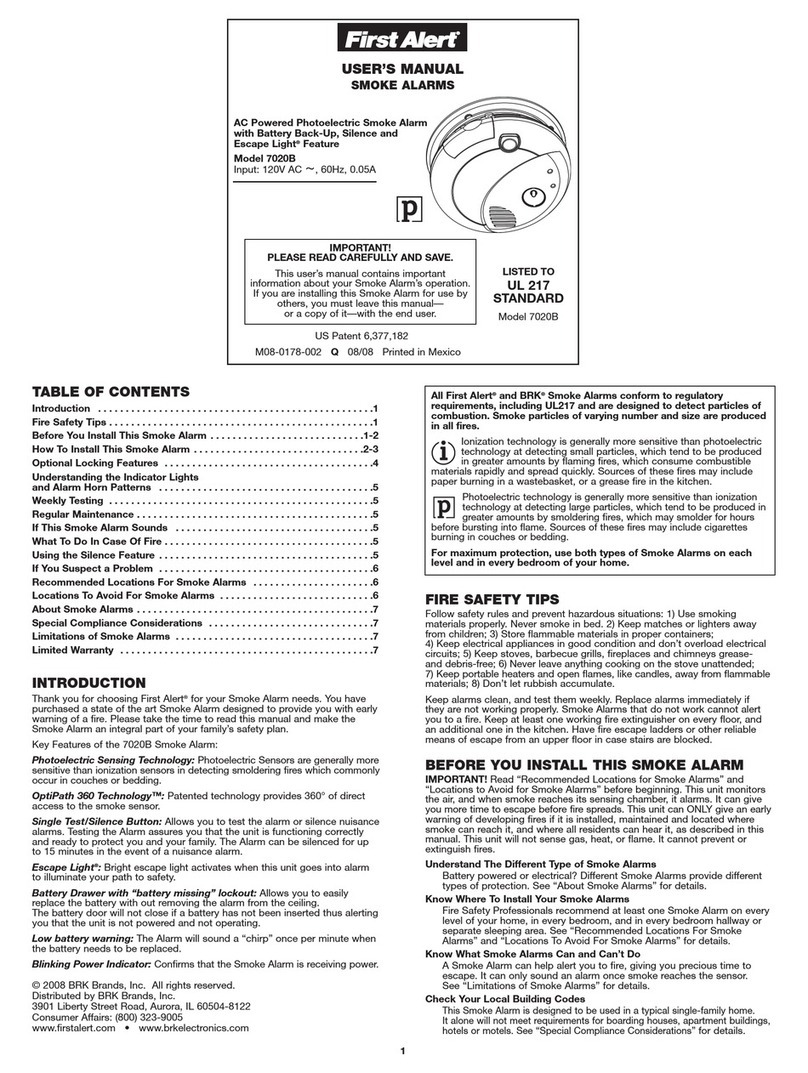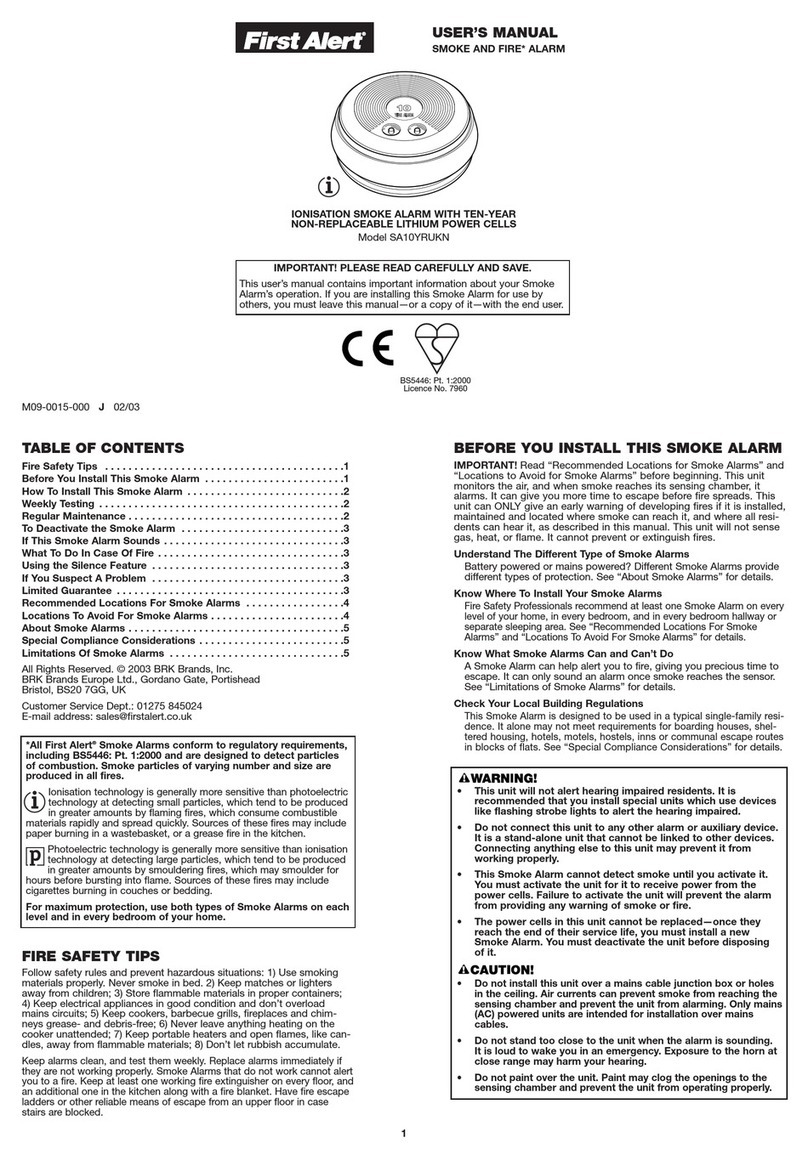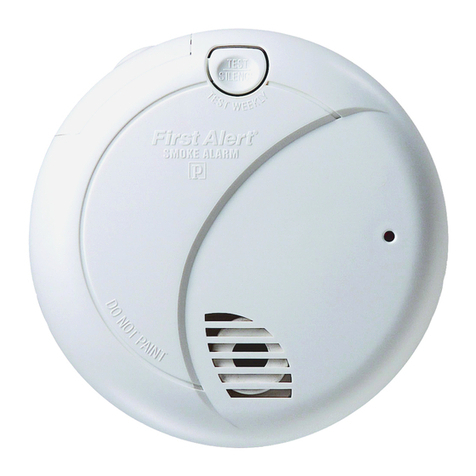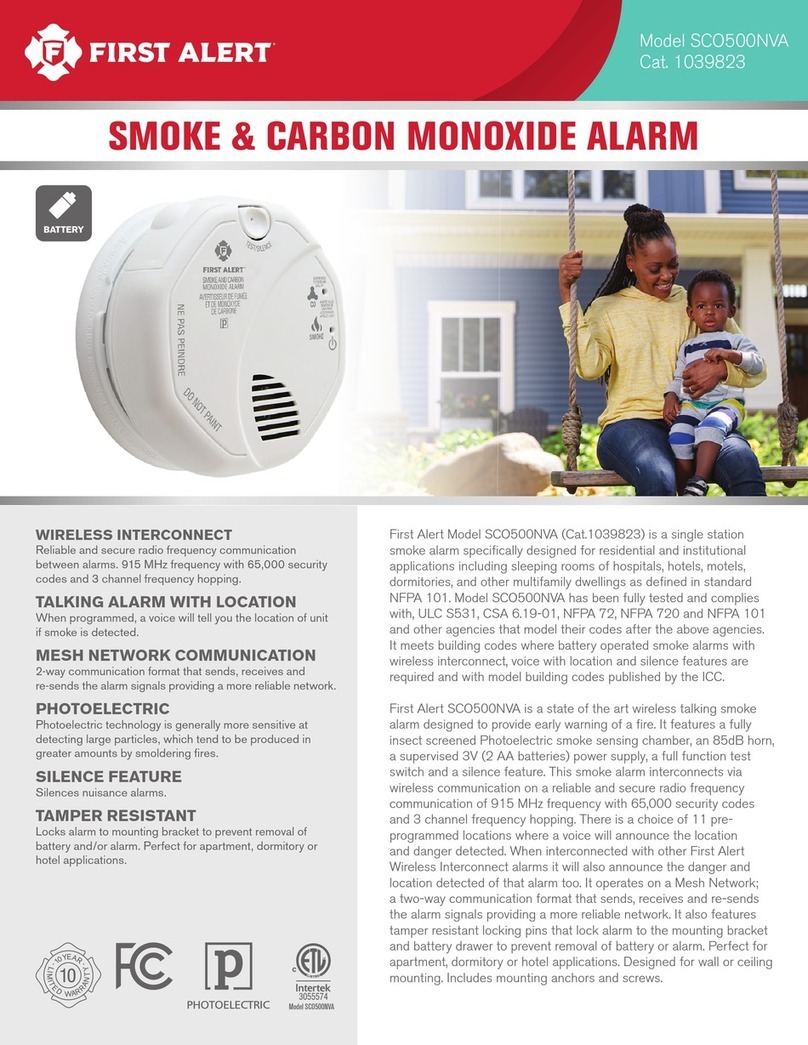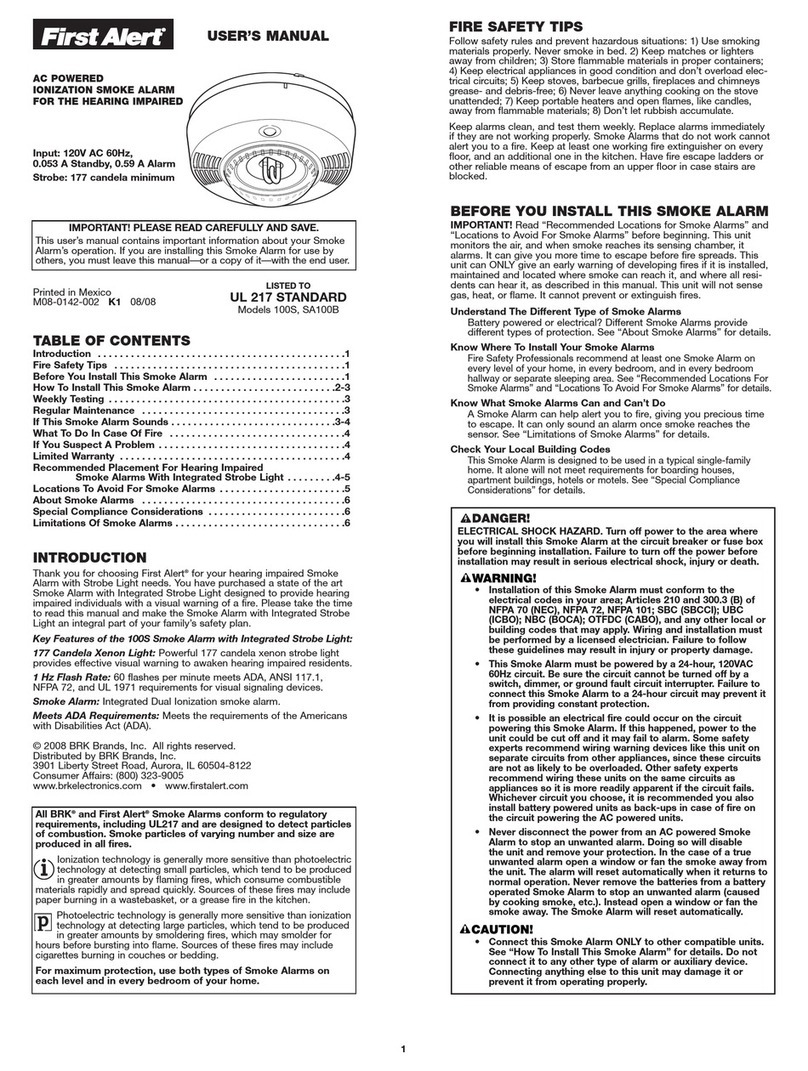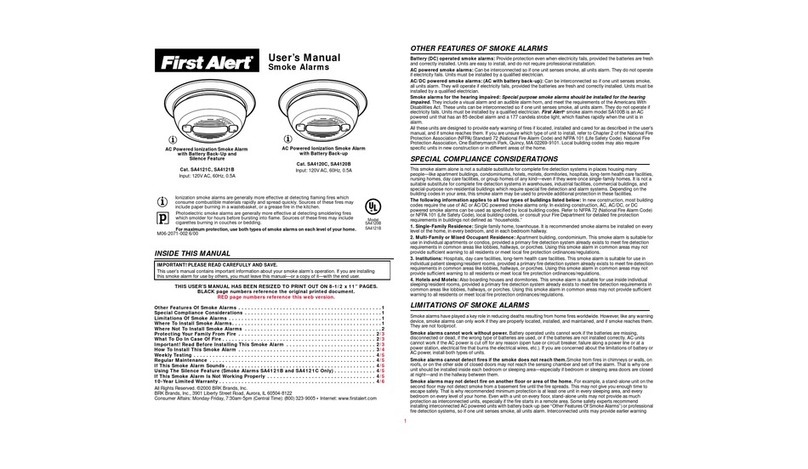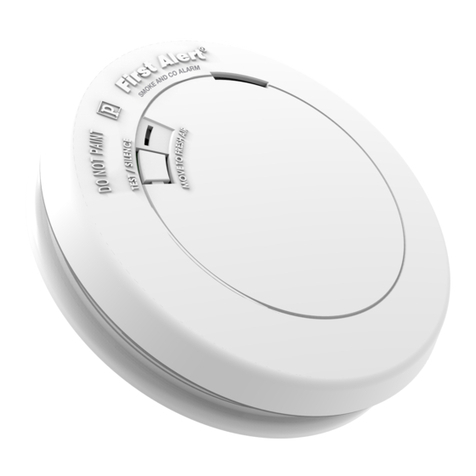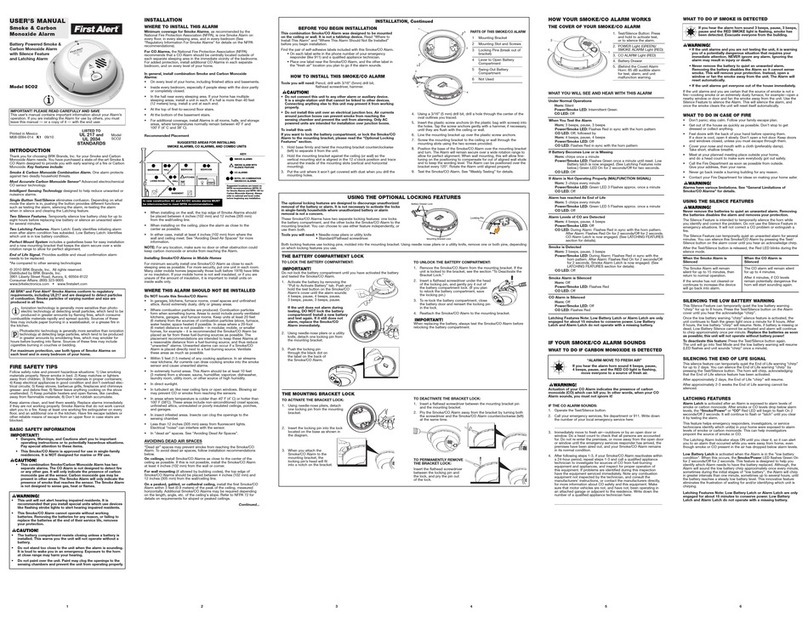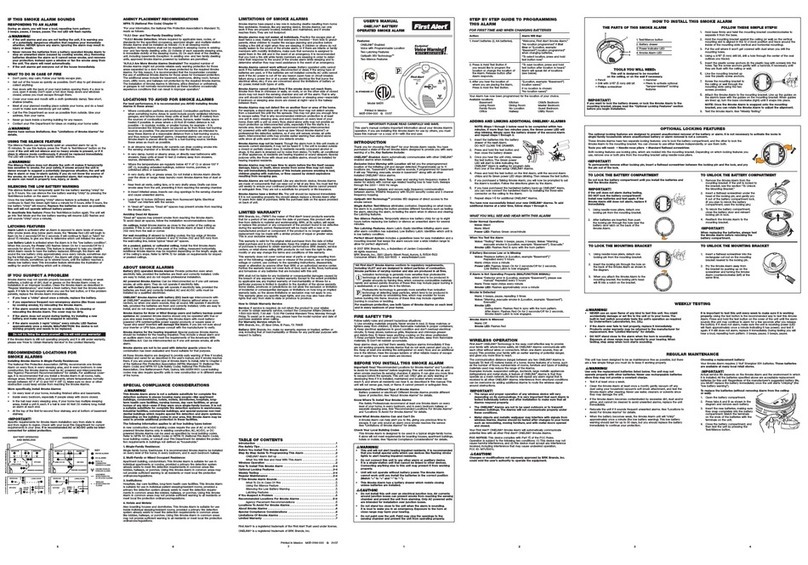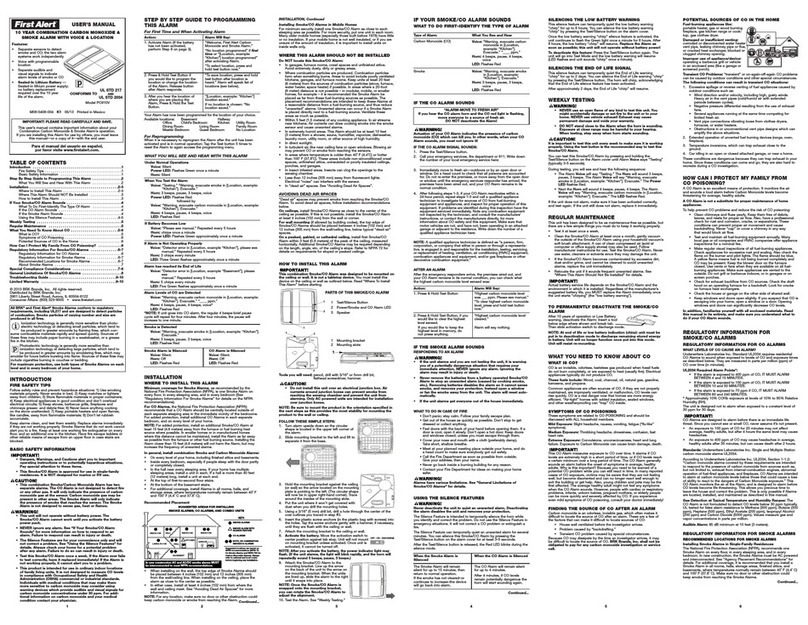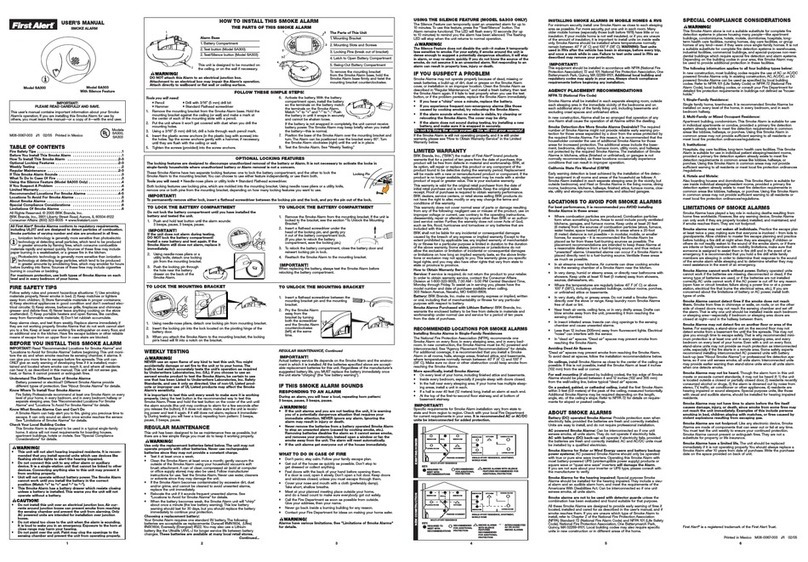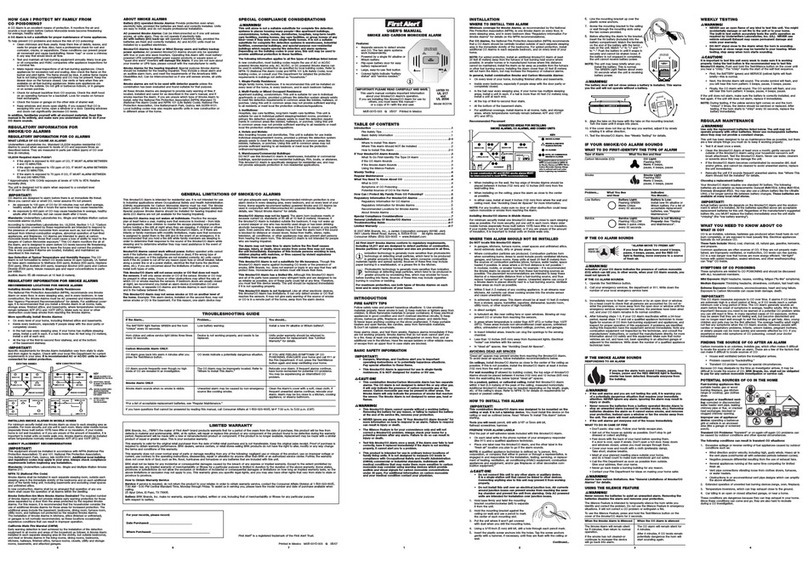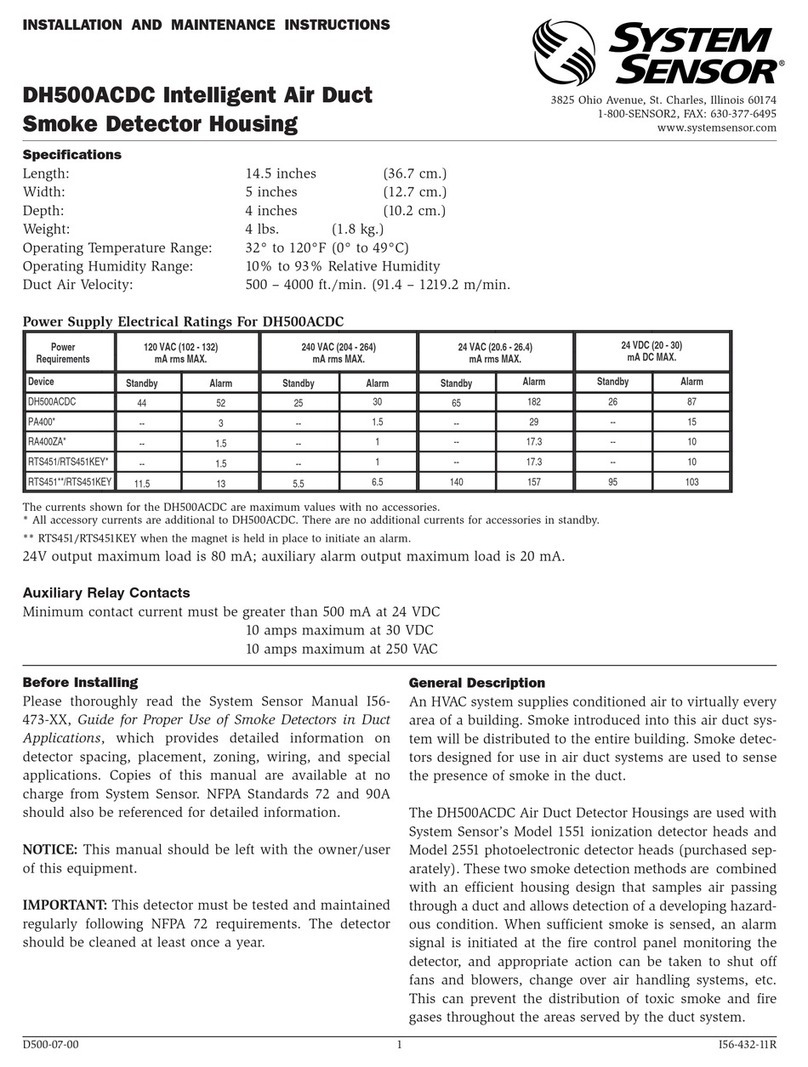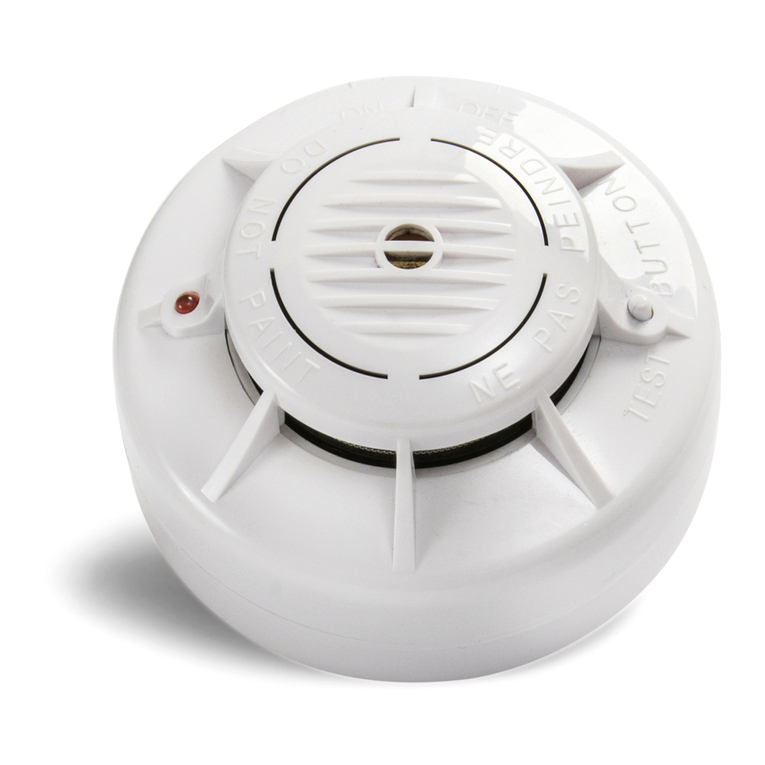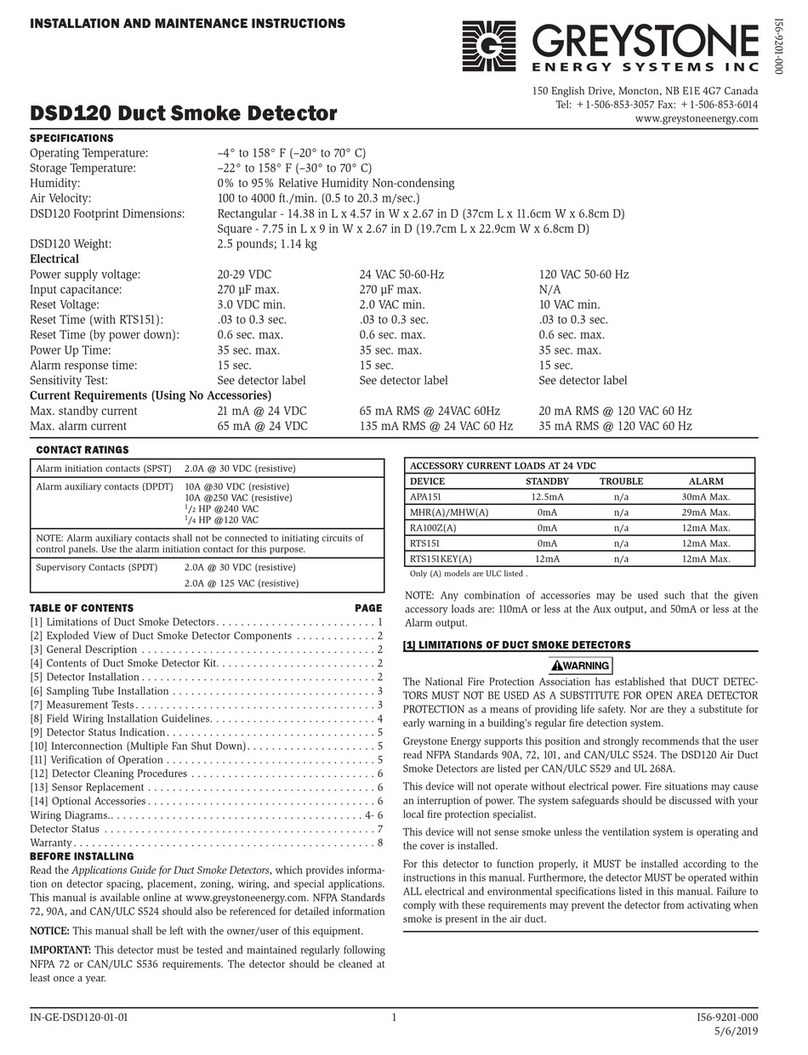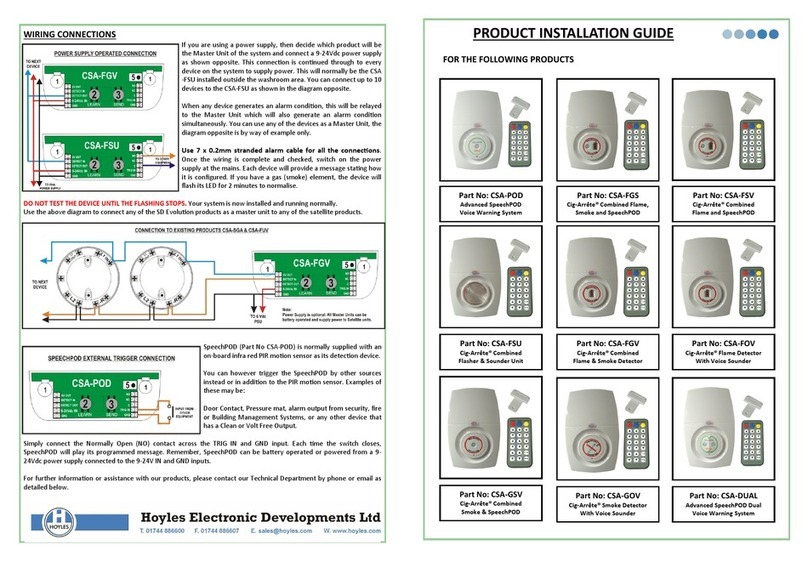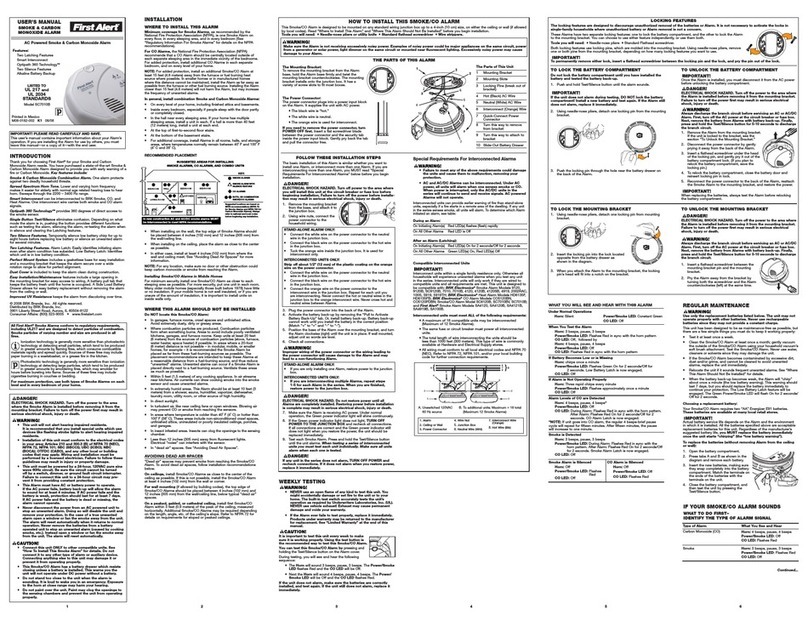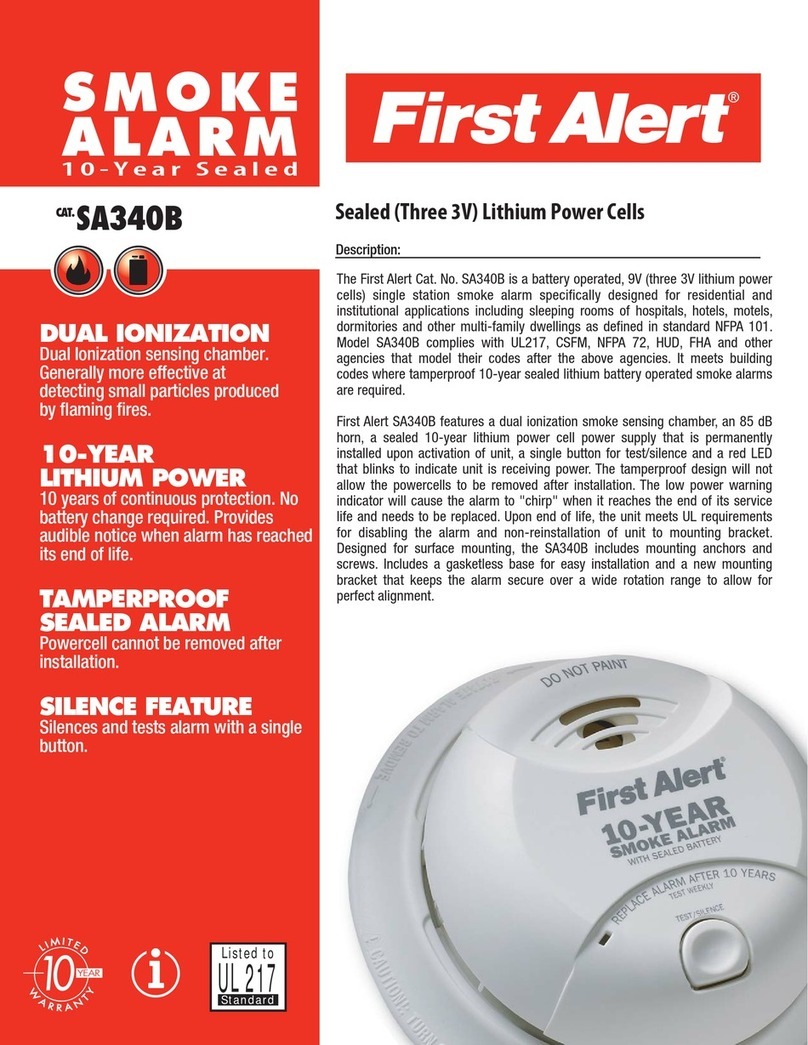LIMITED WARRANTY
BRK Bran s, Inc., ("BRK") the maker of First Alert®bran pro ucts
warrants that for a perio of ten years from the ate of purchase, this
pro uct will be free from efects in material an workmanship. BRK, at
its option, will repair or replace this pro uct or any component of the
pro uct foun to be efective uring the warranty perio . Replacement
will be ma e with a new or remanufacture pro uct or component. If the
pro uct is no longer available, replacement may be ma e with a similar
pro uct of equal or greater value. This is your exclusive warranty.
This warranty is vali for the original retail purchaser from the ate of
initial retail purchase an is not transferable. Keep the original sales
receipt. Proof of purchase is require to obtain warranty performance.
BRK ealers, service centers, or retail stores selling BRK pro ucts o
not have the right to alter, mo ify or any way change the terms an
con itions of this warranty.
This warranty oes not cover normal wear of parts or amage resulting
from any of the following: negligent use or misuse of the pro uct, use on
improper voltage or current, use contrary to the operating instructions,
isassembly, repair or alteration by anyone other than BRK or an
authorize service center. Further, the warranty oes not cover Acts of
Go , such as fire, floo , hurricanes an torna oes or any batteries that
are inclu e with this unit.
BRK shall not be liable for any inci ental or consequential amages
cause by the breach of any express or implie warranty. Except to
the extent prohibite by applicable law, any implie warranty of
merchantability or fitness for a particular purpose is limite in uration
to the uration of the above warranty. Some states, provinces or
juris ictions o not allow the exclusion or limitation of inci ental or
consequential amages or limitations on how long an implie warranty
lasts, so the above limitations or exclusion may not apply to you. This
warranty gives you specific legal rights, an you may also have other
rights that vary from state to state or province to province.
How to Obtain Warranty Service
Service: If service is require , o not return the pro uct to your retailer.
In or er to obtain warranty service, contact the Consumer Affairs
Division at 1-800-323-9005, 7:30 AM - 5:00 PM Central Stan ar Time,
Mon ay through Fri ay. To assist us in serving you, please have the
mo el number an ate of purchase available when calling.
For Warranty Service return to:
BRK Bran s, Inc., 25 Spur Drive, El Paso, TX 79906
Battery: BRK Bran s, Inc. make no warranty, express or implie , written
or oral, inclu ing that of merchantability or fitness for any particular
purpose with respect to battery.
LOCATIONS TO AVOID FOR SMOKE ALARMS, Continued
• In very amp, humi or steamy areas, or irectly near bathrooms with
showers. Keep units at least 10 feet (3 meters) away from showers,
saunas, ishwashers, etc.
• Where the temperatures are regularly below 40˚ F (4.4˚ C) or above 100˚ F
(37.8˚ C), inclu ing unheate buil ings, out oor rooms, porches, or
unfinishe attics or basements.
• In very usty, irty, or greasy areas. Do not install a Smoke Alarm irectly
over the stove or range. Keep laun ry room Smoke Alarms free of ust
or lint.
• Near fresh air vents, ceiling fans, or in very rafty areas. Drafts can
blow smoke away from the unit, preventing it from reaching the sensing
chamber.
• In insect infeste areas. Insects can clog openings to the sensing
chamber an cause unwante alarms.
• Less than 12 inches (305mm) away from fluorescent lights. Electrical
“noise” can interfere with the sensor.
• In “ ea air” spaces. “Dea air” spaces may prevent smoke from
reaching the Smoke Alarm.
Avoiding Dead Air Spaces
“Dea air” spaces may prevent smoke from reaching the Smoke Alarm.
To avoi ea air spaces, follow the installation recommen ations below.
On ceilings, install Smoke Alarms as close to the center of the ceiling as
possible. If this is not possible, install the Smoke Alarm at least 4 inches
(102 mm) from the wall or corner.
For wall mounting (if allowe by buil ing co es), the top e ge of Smoke
Alarms shoul be place between 4 an 12 inches (102 an 305 mm) from
the wall/ceiling line, below typical “ ea air” spaces.
On a peaked, gabled, or cathedral ceiling, install the first Smoke Alarm
within 3 feet (0.9 meters) of the peak of the ceiling, measure horizontally.
A itional Smoke Alarms may be require epen ing on the length, angle,
etc. of the ceiling's slope. Refer to NFPA 72 for etails on requirements for
slope or peake ceilings.
ABOUT SMOKE ALARMS
Battery (DC) operated Smoke Alarms: Provi e protection even when
electricity fails, provi e the batteries are fresh an correctly installe .
Units are easy to install, an o not require professional installation.
However, they o not provi e interconnecte functionality.
AC powered Smoke Alarms: Can be interconnecte so if one unit senses
smoke, all units alarm. They o not operate if electricity fails.
AC with battery (DC) back-up: will operate if electricity fails, provi e the
batteries are fresh an correctly installe . AC an AC/DC units must be
installe by a qualifie electrician.
Wireless Interconnected Alarms: Offer the same interconnecte
functionality as with har wire alarms, without wires. Units are easy to install
an o not require professional installation. They provi e protection even
when electricity fails, provi e the batteries are fresh an correctly installe .
Smoke Alarms for Solar or Wind Energy users and battery backup
power systems: AC powere Smoke Alarms shoul only be operate with
true or pure sine wave inverters. Operating this Smoke Alarm with most
battery-powere UPS (uninterruptible power supply) pro ucts or square
wave or “quasi sine wave” inverters will damage the Alarm. If you are not
sure about your inverter or UPS type, please consult with the manufacturer
to verify.
Smoke Alarms for the hearing impaired: Special purpose Smoke Alarms
shoul be installe for the hearing impaire . They inclu e a visual alarm an
an au ible alarm horn, an meet the requirements of the Americans With
Disabilities Act. These units can be interconnecte so if one unit senses
smoke, all units alarm.
Smoke alarms are not to be used with detector guards unless the
combination has been evaluate an foun suitable for that purpose.
All these Smoke Alarms are esigne to provi e early warning of fires
if locate , installe an care for as escribe in the user’s manual, an if
smoke reaches the Alarm. If you are unsure which type of unit to install, refer
to NFPA (National Fire Protection Association) 72 (National Fire Alarm an
Signaling Co e) an NFPA 101 (Life Safety Co e). National Fire Protection
Association, One Batterymarch Park, Quincy, MA 02269-9101. Local buil ing
co es may also require specific units in new construction or in ifferent areas
of the home.
RECOMMENDED LOCATIONS FOR
SMOKE ALARMS
Installing Smoke Alarms in Single-Family Residences
The National Fire Protection Association (NFPA), recommen s one
Smoke Alarm on every floor, in every sleeping area, an in every be -
room. In new construction, the Smoke Alarms must be AC powere
an interconnecte . See “Agency Placement Recommen ations” for
etails. For a itional coverage, it is recommen e that you install a
Smoke Alarm in all rooms, halls, storage areas, finishe attics, an
basements, where temperatures normally remain between 40˚ F (4.4˚ C)
an 100˚ F (37.8˚ C). Make sure no oor or other obstruction coul
keep smoke from reaching the Smoke Alarms.
More specifically, install Smoke Alarms:
•
On every level of your home, inclu ing finishe attics an basements.
• Insi e every be room, especially if people sleep with oors close .
• In the hall near every sleeping area. If your home has multiple sleep-
ing areas, install a unit in each. If a hall is over 40 feet (12 meters)
long, install an alarm at each en .
• At the top of the first-to-secon floor stairway, an at bottom of
basement stairway.
Specific requirements for Smoke Alarm installation vary from state to
state an from region to region. Check with your local Fire Department
for current requirements in your area. It is recommended AC or AC/DC
units be interconnected for added protection.
LOCATIONS TO AVOID FOR SMOKE ALARMS
For best performance, it is recommended you AVOID installing Smoke
Alarms in these areas:
• Where combustion particles are pro uce . Combustion particles form
when something burns. Areas to avoi inclu e poorly ventilate kitchens,
garages, an furnace rooms. Keep units at least 20 feet (6 meters) from
the sources of combustion particles (stove, furnace, water heater, space
heater) if possible. In areas where a 20-foot (6-meter) istance is not
possible – in mo ular, mobile, or smaller homes, for example – it is
recommen e the Smoke Alarm be place as far from these fuel-burning
sources as possible. The placement recommen ations are inten e to
keep these Alarms at a reasonable istance from a fuel-burning source,
an thus re uce “unwante ” alarms. Unwante alarms can occur if a
Smoke Alarm is place irectly next to a fuel-burning source. Ventilate
these areas as much as possible.
• In air streams near kitchens. Air currents can raw cooking smoke into
the sensing chamber of a Smoke Alarm near the kitchen. Continued...
California State Fire Marshal (CSFM)
Early warning etection is best achieve by the installation of fire etection
equipment in all rooms an areas of the househol as follows: A Smoke
Alarm installe in each separate sleeping area (in the vicinity, but outsi e
be rooms), an Heat or Smoke Alarms in the living rooms, ining rooms,
be rooms, kitchens, hallways, finishe attics, furnace rooms, closets, utility
an storage rooms, basements, an attache garages.
AGENCY PLACEMENT RECOMMENDATIONS
NFPA 72 Chapter 29
“For your information, the National Fire Alarm and Signaling Code,
NFPA 72, rea s as follows:”
29.5.1* Required Detection.
29.5.1.1* Where require by other governing laws, co es, or stan ar s
for a specific type of occupancy, approve single an multiple-station
smoke alarms shall be installe as follows:
(1)*In all sleeping rooms an guest rooms
(2)*Outsi e of each separate welling unit sleeping area, within 21 ft
(6.4 m) of any oor to a sleeping room, with the istance measure
along a path of travel
(3) On every level of a welling unit, inclu ing basements
(4) On every level of a resi ential boar an care occupancy (small
facility), inclu ing basements an exclu ing crawl spaces an
unfinishe attics
(5)*In the living area(s) of a guest suite
(6) In the living area(s) of a resi ential boar an care occupancy
(small facility)
(Reprinte with permission from NFPA 72®, National Fire Alarm an
Signaling Co e Copyright © 2010 National Fire Protection Association,
Quincy, MA 02269. This reprinte material is not the complete an
official position of the National Fire Protection Association, on the
reference subject which is represente only by the stan ar in its
entirety), (National Fire Alarm an Signaling Co e®an NFPA 72®are
registere tra emarks of the National Fire Protection Association, Inc.,
Quincy, MA 02269).
3
SPECIAL COMPLIANCE CONSIDERATIONS
This Smoke Alarm is suitable for use in apartments, con ominiums, town-
houses, hospitals, ay care facilities, health care facilities, boar ing houses,
group homes an ormitories provi e a primary fire etection system
alrea y exists to meet fire etection requirements in common areas like lob-
bies, hallways, or porches. Using this Smoke Alarm in common areas may
not provi e sufficient warning to all resi ents or meet local fire protection
or inances/regulations.
This Smoke Alarm alone is not a suitable substitute for complete fire etec-
tion systems in places housing many people—like apartment buil ings,
con ominiums, hotels, motels, ormitories, hospitals, health care facilities,
nursing homes, ay care facilities, or group homes of any kin . It is not a
suitable substitute for complete fire etection systems in warehouses,
in ustrial facilities, commercial buil ings, an special-purpose non-resi ential
buil ings which require special fire etection an alarm systems. Depen ing
on the buil ing co es in your area, this Smoke Alarm may be use to
provi e a itional protection in these facilities.
In new construction, most buil ing co es require the use of AC or AC/DC
powere Smoke Alarms only. In existing construction, AC, AC/DC, or DC
powere Smoke Alarms can be use as specifie by local buil ing co es.
Refer to NFPA 72 (National Fire Alarm an Signaling Co e) an NFPA 101
(Life Safety Co e), local buil ing co es, or consult your Fire Department for
etaile fire protection requirements in buil ings not efine as “househol s”.
HUD MAP Program
Certain HUD battery powere Smoke Alarm applications, especially those
that fall un er HUD 223(f) MAP (Multi-family Accelerate Processing), may
require a 10 Year seale tamper resistant battery. This alarm oes not meet
that requirement. Substitute First Alert SA340B.
LIMITATIONS OF SMOKE ALARMS
Smoke Alarms have playe a key role in re ucing eaths resulting from home
fires worl wi e. However, like any warning evice, Smoke Alarms can only
work if they are properly locate , installe , an maintaine , an if smoke
reaches them. They are not foolproof.
Smoke alarms may not waken all individuals. Practice the escape plan
at least twice a year, making sure that everyone is involve – from ki s to
gran parents. Allow chil ren to master fire escape planning an practice
before hol ing a fire rill at night when they are sleeping. If chil ren or others
o not rea ily waken to the soun of the smoke alarm, or if there are infants
or family members with mobility limitations, make sure that someone is
assigne to assist them in fire rill an in the event of an emergency. It is
recommen e that you hol a fire rill while family members are sleeping
in or er to etermine their response to the soun of the smoke alarm while
sleeping an to etermine whether they may nee assistance in the event
of an emergency.
Smoke Alarms cannot work without power. Battery operate units cannot
work if the batteries are missing, isconnecte or ea , if the wrong type
of batteries are use , or if the batteries are not installe correctly. AC units
cannot work if the AC power is cut off for any reason (open fuse or circuit
breaker, failure along a power line or at a power station, electrical fire that
burns the electrical wires, etc.). If you are concerne about the limitations
of battery or AC power, install both types of units.
Smoke Alarms cannot detect fires if the smoke does not reach them.
Smoke from fires in chimneys or walls, on roofs, or on the other si e of
close oors may not reach the sensing chamber an set off the alarm. That
is why one unit shoul be installe insi e each be room or sleeping area—
especially if be room or sleeping area oors are close at night—an in the
hallway between them.
Smoke Alarms may not detect fire on another floor or area of the home.
For example, a stan -alone unit on the secon floor may not etect smoke
from a basement fire until the fire sprea s. This may not give you enough
time to escape safely. That is why recommen e minimum protection is
at least one unit in every sleeping area, an every be room on every level
of your home. Even with a unit on every floor, stan -alone units may not
provi e as much protection as interconnecte units, especially if the fire
starts in a remote area. Some safety experts recommen installing intercon-
necte AC powere units with battery back-up (see “About Smoke Alarms”)
or professional fire etection systems, so if one unit senses smoke, all units
alarm. Interconnecte units may provi e earlier warning than stan -alone
units since all units alarm when one etects smoke.
Smoke Alarms may not be heard. Though the alarm horn in this unit meets
or excee s current stan ar s, it may not be hear if: 1) the unit is locate
outsi e a close or partially close oor, 2) resi ents recently consume
alcohol or rugs, 3) the alarm is rowne out by noise from stereo, TV, traffic,
air con itioner or other appliances, 4) resi ents are hearing impaire or
soun sleepers. Special purpose units, like those with visual an au ible
alarms, shoul be installe for hearing impaire resi ents.
Smoke Alarms may not have time to alarm before the fire itself causes
damage, injury, or death, since smoke from some fires may not reach
the unit immediately. Examples of this include persons smoking in bed,
children playing with matches, or fires caused by violent explosions
resulting from escaping gas.
Smoke Alarms are not foolproof. Like any electronic evice, Smoke Alarms
are ma e of components that can wear out or fail at any time. You must test
the unit weekly to ensure your continue protection. Smoke Alarms cannot
prevent or extinguish fires. They are not a substitute for property or life
insurance.
Smoke Alarms have a limited life. The unit shoul be replace imme iately
if it is not operating properly. You shoul always replace a Smoke Alarm
after 10 years from ate of purchase. Write the purchase ate on the space
provi e on back of unit.
First Alert®is a registere tra emark of the First Alert Trust.
Printe in China M08-0410-006 01/13
IF YOU SUSPECT A PROBLEM, Continued
• If the alarm sounds when no smoke is visible, try cleaning or
relocating the Smoke Alarm. The cover may be dirty.
• If the alarm does not sound during testing, try installing a new
battery, and make sure it is snapped in securely.
If the Smoke Alarm is still not operating properly, an it is still un er
warranty, please see “How to Obtain Warranty Service” in the Limite
Warranty.
Do not try fixing the alarm yourself – this will void your warranty
4
